Leakage Control
Published on by Water Network Research, Official research team of The Water Network in Technology
Many methods for controlling leakage from urban water supply systems have emerged, but leakage remains a challenge in developing countries.
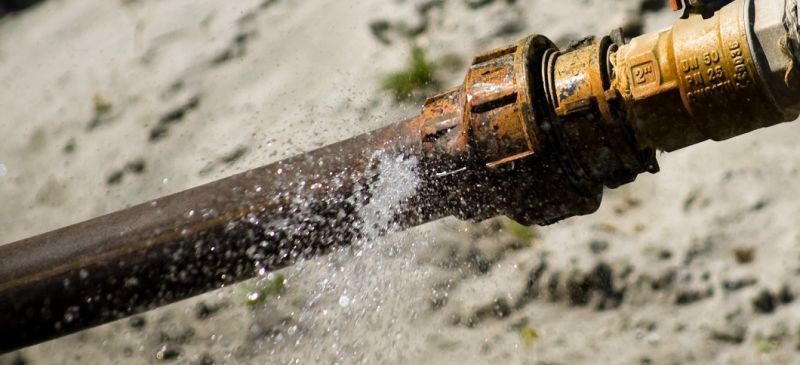
Compiled by:
Florian Faure (seecon international gmbh);
M.M. Pandit (Indian Water Works Association, IWWA);
Dorothee Spuhler (seecon international gmbh).
Source: Sustainable Sanitation and Water Management (SSWM)
Executive Summary
Water leakage is an important component of water losses. Many methods for controlling leakage from urban water supply systems have emerged, but it remains a challenge in developing countries, especially those with intermittent water supplies. Specific methods have been developed for such systems, used in combination with adaptations of more usual methods.
Introduction
Leaks are the major component of water loss in developed countries. This is not always true for developing countries, but it remains an important factor of water wastage. Illegal connections, metering and accounting errors as well as pricing issues should be addressed in priority, but leakage control remains an effective tool for limiting water losses.
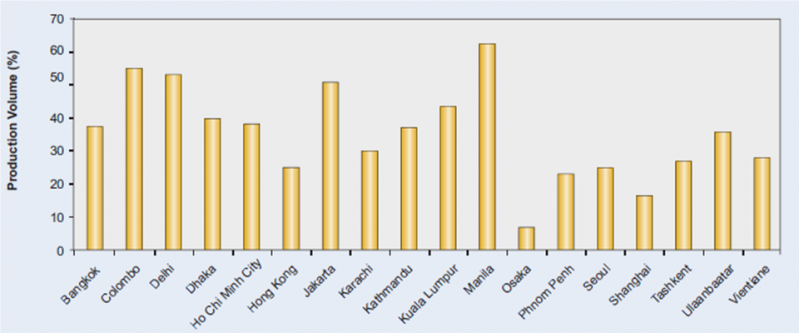
Non-revenue water expressed as percentage of the total produced volume of drinking water in major Asian cities (up to 65%, with an average of 30%). Non-revenue water is a major issue in developing countries, seriously undermining efforts to develop sustainable water supply systems. Source: MCINTOSH (2003)
Process and Basic Principles
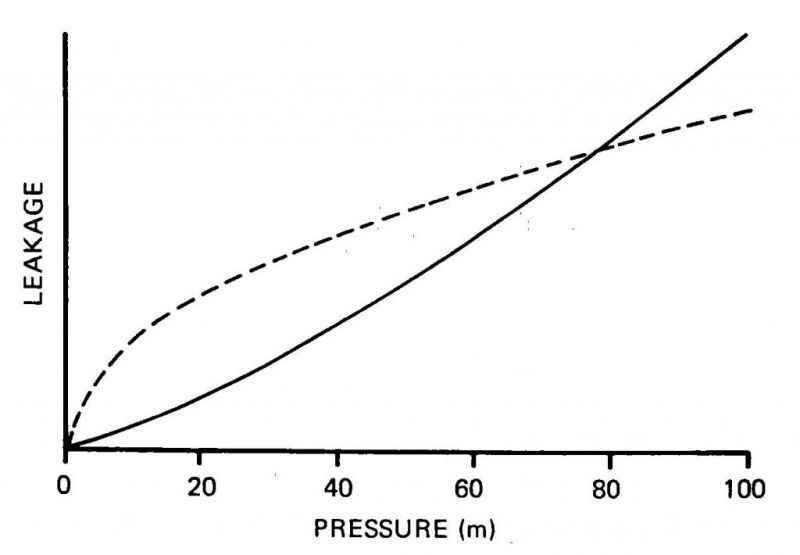 As an example of the main factors affecting leakage: the more pressure in the main the more leakage, as shown by the continuous line. (Left picture; Source: WAA et al. (1985))
As an example of the main factors affecting leakage: the more pressure in the main the more leakage, as shown by the continuous line. (Left picture; Source: WAA et al. (1985))
A water system includes intakes, water pipelines, storage reservoirs and pumps. Once the water enters the system at the intakes from the source, pumps provide energy to convey the water through the pipelines to storage reservoirs from which it is distributed to consumers.
Pipelines are formed of multiple pipes with joints and leakage generally occurs where the pipe joints are faulty or where defects develop in the pipe body. The longer leaks remain unattended the larger the economic and resource loss will be to the authorities, as electric power to run the pumps and chemicals to treat water are also wasted.
Pressure in mains, water hammers, soil instability, corrosion of water pipes, poor quality of fittings, traffic loading, age of components are some of the main factors affecting leakage. Leakage control work involves the following major step.
Leakage control work involves the following major steps:
- Preparatory work: updating maps, databases of consumer connections, residing population, water mains, valves and fire hydrants etc.; planning of activities.
- Test for loss assessment and locating the defects (leak detection).
- Repair and replacement of system components.
- Re-assessment, several times if needed.
- Program monitoring.
- Build up procedures and standardised activities applied to the considered system.
- Training of staff, including training of trainers and updating.
Leak Detection
Major leaks can be visible on the surface: these have to be fixed in priority. It is the first and most import step of leaks control in developing countries.
Purchasing leak detection instruments is an approach typical of developed countries, but not necessarily the most adapted one for developing countries (FARLEY 2001, MCINTOSH 2003). Leakage assessment uses various techniques such as district and/or wastage metering, pressure control, sounding or passive leakage control for continuous supply.
For intermittent supply, the mobile tanker, stop tap, or district meter methods as well as pressure, sounding or passive leakage controls can be used. The selection of a method has to be based on local conditions and resources (see also FARLEY 2001 for the description of most methods and their applicability).
Continuous Supply Systems
It is common in continuous supply systems to measure district flow at night and find a minimum, known as “minimum night flow”. For cost-effective work, district metering is typically done for 2000 to 5000 properties; waste metering is typically done for about 1000 to 3000 properties.
These methods are now well established and have been well documented. However, specific reference books / manuals need to be consulted for the adaptation of these methods to intermittent supply.
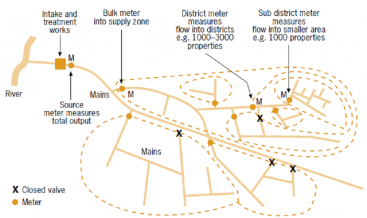 District metering areas (DMA) design options, and metering hierarchy. (Left picture; Source FARLEY (2001)
District metering areas (DMA) design options, and metering hierarchy. (Left picture; Source FARLEY (2001)
Using electronic instruments, noise detection principles can be applied by listening to the pipelines and filtering external noises, amplifying the leak-noise of certain frequency range to detect and pin-point the leaks.
Advanced state-of-the-art instruments such as electronic sounding rods, multi-frequency leak locators, leak noise correlators or noise loggers also exist. Depending on the chosen technique, instruments may be combined.
For continuous supply systems properly metered (usually those of developed countries), software packages such as ‘BABE’ (Burst & Background Estimates) help assessing the annual volume lost for different categories of leaks, depending on their average duration.
Intermittent Supply Systems
For intermittent supply systems, the mobile tanker method has been developed. A small main stretch (typically 100 connections and 400 to 500 meters) is isolated and fed under pressure during non-supply hours, long enough to measure leak flows and locations. Boundary valves and consumer connections are closed.
The line supplying the injection point from the tanker contains a meter with a pulsehead, a pressure transducer and a data logger that records pressure and flow (FARLEY & TROW 2003; CPHEEO 2005). A direct measure of leakage, otherwise difficult to locate during short supply hours, can be obtained.
The method has been used at large scales in the metropolitan cities of Chennai, Hyderabad, Ahemdabad (India) and Kathmandu (Nepal).
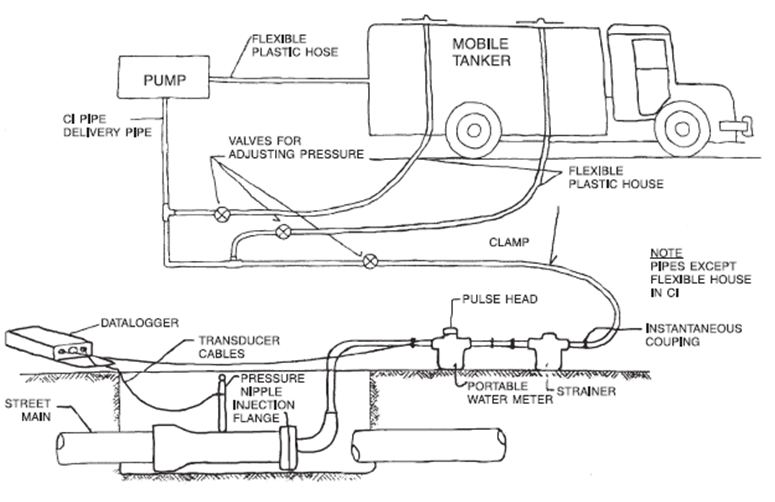 The mobile tanker method is one of the most cost-effective methods: it requires little material and manpower, and does not need installed consumer meters or district meters.
The mobile tanker method is one of the most cost-effective methods: it requires little material and manpower, and does not need installed consumer meters or district meters.
Work does not need to be repeated as small stretches are isolated for testing purpose and all defects can be found and repaired within each part.
Another method for intermittent supplies is the stop tap method (adapted from FARLEY 2001): boundary valves and customer's connections stop taps are closed.
A special supply is arranged from the nearest water distribution station, and the water flow is directly metered through the test area. Basic leak detection equipment is then used to locate the leak points.
The main problem with this method, as compared to the mobile tanker method, is the need to divert water supplies to the test area. It also wastes a lot of water, lost at the leak points during the test, and has to be repeated as only a few leaks are detected each time.
Operation and Maintenance
Leakage control is a regular maintenance activity and needs to be given priority, and to be included in the routine maintenance activities by establishing a separate department dedicated to it. Reporting by this department should also include the cost of water saved and the cost of the implemented program.
Zonal caretakers reporting to O&M (operation and maintenance, see also (see also water distribution and [1879 water purification])) supervisors can be efficient in the follow-up of water leaks and other losses, if familiar enough with the water network and the inhabitants of each zone (MCINTOSH 2003).
Health Aspects
In intermittent supply systems, leak points become likely entrances for contamination as pipelines are not under pressure outside supply hours: locating leaks and repairing them helps closing the contamination-prone areas of the water pipeline network and improves the safety of the water.
Applicability
All piped networks are subject to leaks and should be controlled. Maximum leakage occurs on pipelines from which consumer connections are laid, caused for example by faulty joints or corroded ferrule joints. Due to the large time span between occurrence of underground leakage on such pipelines and the repair, water lost due to the underground leak-flows exceeds by far the water lost due to bursts from larger pipelines.
An efficient routine maintenance can lead to substantial resource and financial savings. Each method has its own applicability; as an example, the mobile tanker method is applicable on pipelines up to diameters of 150 mm (general size in urban area), especially that of intermittent supply systems.
Advantages
- Detecting leaks helps saving water resources, costs and energy
- More water is available to consumers and can be billed
- Water recontamination after centralised treatment is less likely to happen in the pipes
Disadvantages
- Conventional leak detection equipment is often expensive and more adapted methods have to be chosen in developing countries
- Leaks are only a small part of non-revenue water in developing countries
- Governance and pricing must be a priority in water supply management
- Some of the leak detection methods involve interruption of the supply leading to consumers’ dissatisfaction
References
CPHEEO (Editor) (2005): Chapter 15. Water Audit and Leakage Control. In: CPHEEO (Editor) (2005): Manual on Operation and Maintenance of Water Supply Systems. New Delhi, 343-368.URL [Accessed: 02.06.2010]. PDF
FARLEY, M.; TROW, S. (2003): Losses in Water Distribution Networks. A Practitioners Guide to Assessment, Monitoring and Control. London: IWA Publishing.
FARLEY, M. (2001): Leakage Management and Control. A best Practice Manual. Geneva: World Health Organisation (WHO). URL [Accessed: 26.05.2010]. PDF
MCINTOSH, A.C. (2003): Asian Water Supplies. Reaching the Urban Poor. Asian Development Bank (ADB) and International Water Association (IWA). URL [Accessed: 26.07.2010]. PDF
NEPAL WATER SUPPLY CORPORATION (Editor); TATA CONSULTING ENGINEERS (Editor); CEMAT CONSULTANTS (PVT) LTD (Editor); ENTEC OPERATIONAL SERVICES (Editor) (1995): Nepal: Leak Detection and Waste Control Program. Seminar proceedings.
PANDIT, M.M. (1990): Innovative Approach to Leakage Control in Intermittent Supply Systems. In: TCE News Quarterly XI 46.
SIDHAYE, V.M. (1987): Leak Detection and Waste Prevention in Water Distribution Systems. Mumbai: Indian Water Works Association.
TATA CONSULTING ENGINEERS (Editor); BINNIE & PARTNERS (Editor); THAMES WATER AUTHORITIES ABBREVIATIONS (Editor) (1992): Study on Reduction in Unaccounted for Water in Madras City.
WAA (Editor); WRC (Editor) (1985): Leakage Control Policy and Practice. London: Water Authorities Association (WAA), Water Research Centre (WRC), Technical Working Group on Waste Water. URL [Accessed: 16.08.2010]. PDF
Further Readings
ADB (Editor) (2007): Curbing Asia's Nonrevenue Water . (= Water for All Water Briefs). Asian Development Bank (ADB). URL [Accessed: 29.07.2010]. PDF
Water brief on non-revenue water in Asia (30% of its production) examples of applicable measures and positive results.
EPD (Editor) (2007): Water Leak Detection and Repair Program. (= EPD Guidance Document). Georgia: Environmental Protection Division (EPD). URL [Accessed: 14.07.2010]. PDF
Part 1 presents the essentials of leak detection and repair, and could be used as a basis for awareness raising material or at least a quick overview of the topic (importance of leak detection, major causes, identification). Part 2 provides information on a comprehensive leak detection and repair program.
LAHLOU, Z.M. (2001): Leak Detection and Water Loss Control . (= National Drinking Water Clearinghouse Tech Brief No 17). Morgantown: National Environmental Services Centre (NESC). URL[Accessed: 14.07.2010]. PDF
Concise and technical information aimed at small systems, describing the methods used to detect, locate and correct leaks. Also available in Spanish.
LIEMBERGER, R.; FARLEY, M. (2004): Developing a Non-Revenue Water Reduction Strategy. Marrakech: International Water Association (IWA). URL [Accessed: 29.07.2010]. PDF
Paper presented at the IWA's fourth World Water Congress in Marrakech. Guide to elaborate a “universal” non-revenue water reduction strategy, also applicable in developing countries. Divided in two parts. Part 1: Investigating and Assessing Water Losses, Part 2: Planning and Implementing the Strategy.
MCINTOSH, A.C. (2003): Chapter 9. Non-Revenue Water. In: MCINTOSH, A.C. (2003): Asian Water Supplies. Reaching the Urban Poor. . URL [Accessed: 28.07.2010]. PDF
Compilation of the water balance and non-revenue water in Asia. The publication contains strategies to reduce non-revenue water and other losses through case study, examples and practical measures.
NGUYEN, C.T. (2005): Non-Revenue water Assessment. Hanoi: South East Asian Water Utilities Network (SEAWUN). URL [Accessed: 29.07.2010]. PDF
Summary, basic principles and many definitions of water balance and the focus areas to reduce non-revenue water.
WAA (Editor); WRC (Editor) (1985): Leakage Control Policy and Practice. London: Water Authorities Association (WAA), Water Research Centre (WRC), Technical Working Group on Waste Water.URL [Accessed: 16.08.2010]. PDF
This technical working group came up with the techniques for assessment and detection of leaks, but also developed guidelines for use of units to express leakage for further comparison with other areas in the same zone, amongst zones, amongst different systems in the same city and to compare systems of different cities bringing them on a common footing. It also presents possible targeted and good practice values.
GIZ (Editor) (2011): Guidelines for Water Loss Reduction. A Focus on Pressure Management. Eschborn: Deutsche Gesellschaft für Internationale Zusammenarbeit (GIZ) GmbH. URL [Accessed: 21.05.2012]. PDF
These guidelines aim to impart knowledge about water loss reduction to decision-makers and stakeholders at the national level and to the management team, planning and design department and operating staff at local water utilities in developing and transition countries. The guidelines are accompanied by capacity development materials as well as the implementation of pilot projects in order to transfer know-how and implement state-of-the art pressure management (PM) technology in practice.
UN-HABITAT (2013): Water Audit Manual. (= Utility Management Series for Small Towns, 4). Nairobi: UN-HABITAT. URL [Accessed: 08.04.2013]. PDF
The Water Audit manual gives guidance on all aspects from when water gets to the distribution system to when water finally gets to the consumer. The scope of this water balance manual covers all aspects from the water supplied to the distribution system as well as water losses and/or used with the distribution system and what eventually reaches to the customer¿s premises and is billed/converted into revenue for the utility. The manual covers the procedures for determination of the various components of the water balance.
Case Studies
LUPO, F.; NGUYEN, P.A.; NGUYEN, N.H. (2005): Non Revenue Water Reduction. (= Non Revenue Water Reduction). FLUIDIS-WMI. URL[Accessed: 29.07.2010]. PDF
Case study presentation on Ibague, Colombia, to reduce non-revenue water. Leak detection campaign and commercial losses action plan.
PANDIT, M.M. (2010): Madras Metropolitan Water Supply and Sewerage Board. Reduction in Unaccounted for Water in Madras City. PDF
Description of how the Mobile Tanker Method has been successfully implanted in Madras, India, to obtain a 90% leakage reduction.
RIZZO, A. (2001): Strategic Management of Water Leakage in the Maltese Islands. Luqa: Water Services Corporation. URL [Accessed: 14.07.2010]. PDF
An efficient leakage control and reduction campaign on the Maltese islands had five major focuses: pressure management, active leakage localisation, dynamic leakage repair, network rationalisation and replacement of critically weak pipe work.
Training Material
AGRAWAL, P.C. (2008): Performance Improvement Planning. Designing an Effective Leakage Reduction and Management Program. (= Field Note No. 3). Washington: Water and Sanitation Program (WSP). URL [Accessed: 16.08.2010]. PDF
Field note on the implementation of non-revenue water programs through case studies of service providers in India and Vietnam. It describes the managerial and accountability instruments developed, complementary to technical measures.
CPHEEO (Editor) (2005): Chapter 15. Water Audit and Leakage Control. In: CPHEEO (Editor) (2005): Manual on Operation and Maintenance of Water Supply Systems. New Delhi, 343-368. URL[Accessed: 02.06.2010]. PDF
Manual aimed at professionals, for leakage assessment and detection, providing details concerning the main methods and guidelines for their application.
FARLEY, M. (2001): Leakage Management and Control. A best Practice Manual. Geneva: World Health Organisation (WHO). URL[Accessed: 26.05.2010]. PDF
Reference training manual aimed at professionals responsible for operation and maintenance of water supply systems. It is designed to raise the level of training, make maximum use of resources, and help the implementation of training activities.
HARRELL, T. (2009): Arizona Water Company's Leak Detection Program. Arizona Water Company. URL [Accessed: 16.08.2010]. PDF
Overview presentation of a leak detection program, aimed at professionals. Basic equipment and planning.
PEDERSEN, J. (2005): Water Distribution Management and Reduction. (= Presentation). Denmark: Watertech Ltd. URL [Accessed: 16.08.2010]. PDF
Presentation dealing with importance of controlling non-revenue water and managing water distribution. Different tools to do so and in particular to control leakage are presented. This publication also contains a case study from Thailand.
PILCHER, R.; HAMILTON, S.; CHAPMAN, H.; FIELD, D.; RISTOVSKI, B.; STAPELY, S. (2007): Leak Detection and Repair. (= Guidance Notes). International Water Association (IWA). URL [Accessed: 16.08.2010]. PDF
Guidance notes aimed at staff with little or no experience in leak detection and location techniques and practices. Compilation of international leakage expert's key best practices and technical understandings.
WASHINGTON STATE DEPARTMENT OF HEALTH (Editor) (2008):Reduce Leaks Using Water Audits and Leak Detection Surveys. Tumwater: Office of Drinking Water (ODW). URL [Accessed: 27.07.2010]. PDF
Aimed at professionals, this 6-page publication explains how to calculate a leakage rate and detect and repair leaks.
FARLEY, M. (2005): Managing Losses in Water Distribution Networks. PDF Presentation. URL [Accessed: 21.05.2012]. PDF
A presentation about an international strategy for an international problem.
UN-HABITAT (2013): Leakage Control Manual. (= Utility Management Series of Small Towns, 5). Nairobi: UN-HABITAT. URL [Accessed: 02.04.2013]. PDF
It describes the objectives and functioning of a leakage control programme. The objectives of a Leak detection Programme (LRP) are: i. To reduce physical water losses through proactive visible-leak search campaigns and pressure regulation in all zones; ii. To reduce physical losses through prompt leak repairs in the entire water supply system / network.
Important Weblinks
http://www.waterloss-reduction.com/ [Accessed: 11.08.2010]
Website of a public-private partnership with the German Federal Ministry for Economic Cooperation and Development (GTZ), aiming at reducing the drinking water loss through intelligent pressure management. Guidelines, capacity development tools and a knowledge base are to be found.
http://www.adb.org/ [Accessed: 29.07.2010]
Asian Development Bank (ADB) website, non revenue water section: non-revenue water components, related concepts and definitions, „caretaker approach“ etc.
http://www.hyderconsulting.com/ [Accessed: 29.07.2010]
Webpage summarising general water leaks management: active leakage control and sectorisation, infrastructures, repairs and pressure management.
Media
Taxonomy
- Leakage Detection
- Water Supply
- Leakage
- Urban Water Infrastructure
- Pipes and Pipelines
2 Comments
-
Relevant information for creating awareness among all stakeholders.
-
Good data for knowledge sharing!